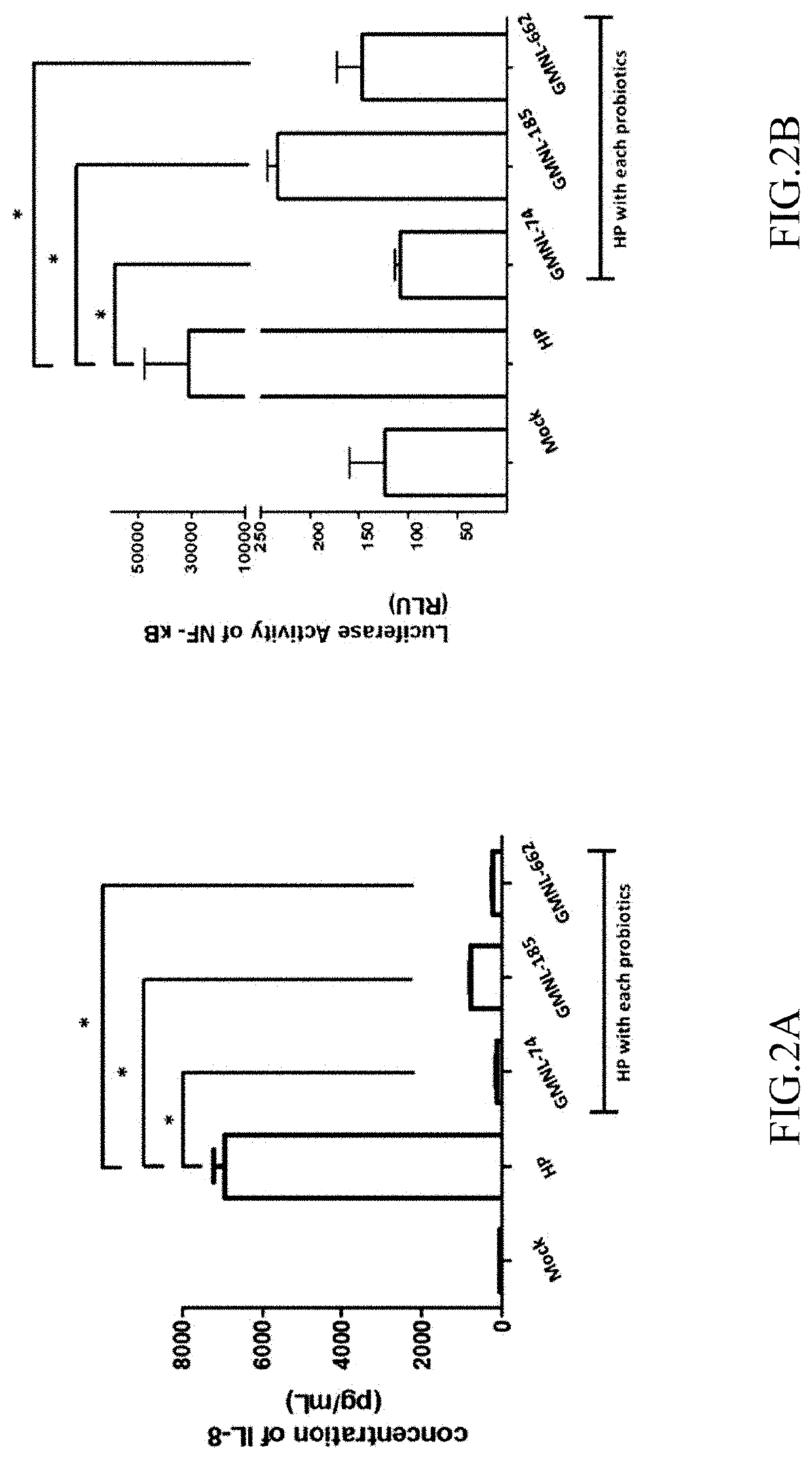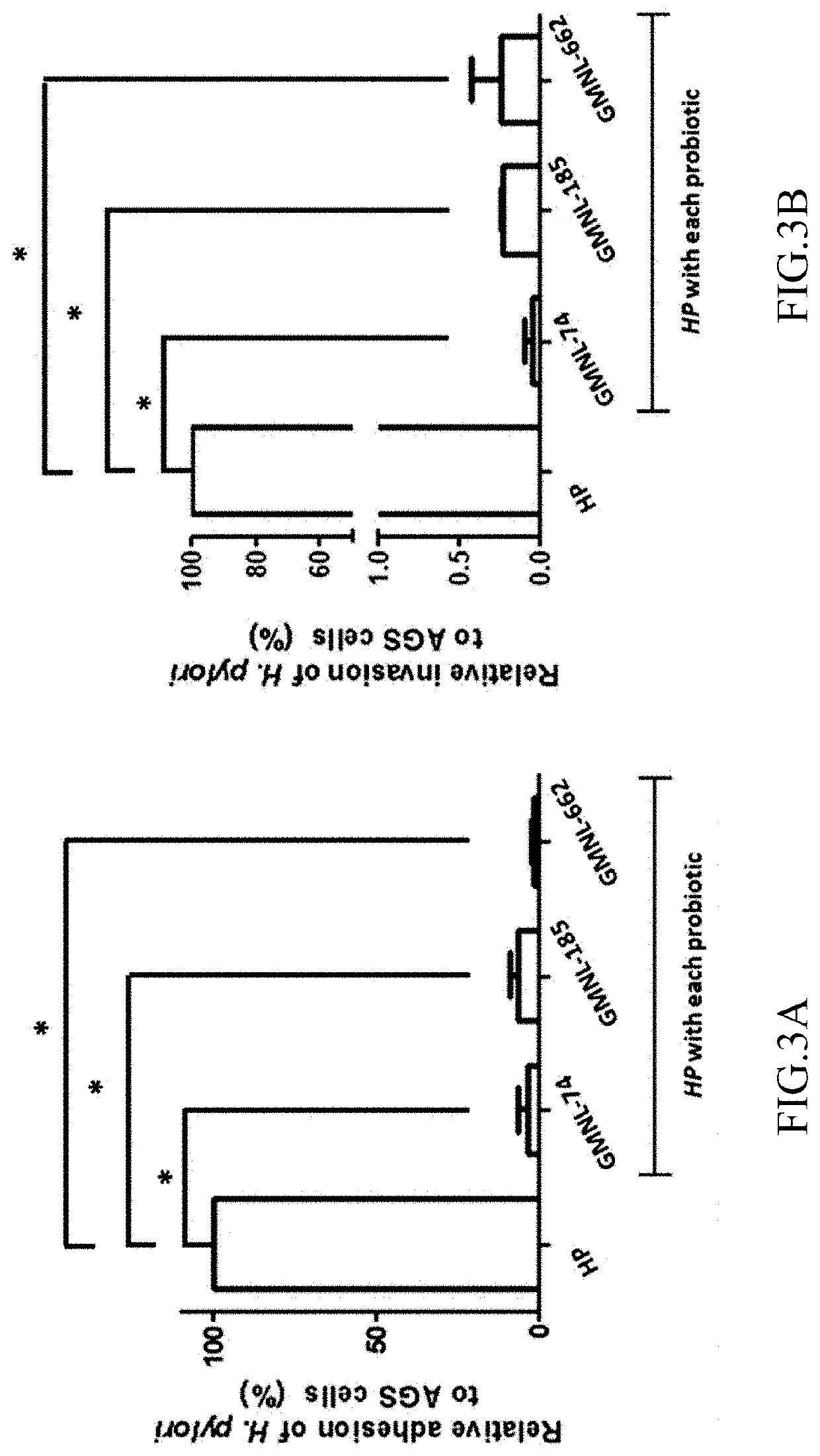Lactobacillus composition for inhibiting gastritis induced by gastric helicobacter pylori and use thereof
a technology of lactobacillus and gastritis, which is applied in the field of lactobacillus composition for inhibiting gastritis induced by gastric helicobacter pylori, can solve the problems of gastritis, nausea, diarrhea, flatulence, etc., and achieve the effect of inhibiting the expression of gastric cox-2 protein
- Summary
- Abstract
- Description
- Claims
- Application Information
AI Technical Summary
Benefits of technology
Problems solved by technology
Method used
Image
Examples
embodiment 1
[0028]Screening Lactobacillus composition that can be highly adhered to human gastric cells (AGS).
[0029]After human gastric epithelial cells AGS (ATCC CRL 1739) and activated Lactobacillus solution (multiplicity of infection MOI 100) are co-cultivated for 2 hours, the non-adhered bacteria are washed out with PBS and the cells are stained with Giemsa stain. The number of Lactobacillus adhered on the human gastric epithelial cells (AGS) is observed by using a microscope to evaluate the adhesion strength of the strains.
[0030]FIG. 1 shows the observation under the field of view of an oil immersion lens that if more than 40 Lactobacillus strains are adhered on the cells (as shown in FIG. 1 diagram A), they are expressed by “++++”, indicating the ability to bind to the cells is the strongest; if more than 20 Lactobacillus strains are adhered on the cells (as shown in FIG. 1 diagram B), they are expressed by “+++”; if more than 10 Lactobacillus strains are adhered on the cells (as shown in...
embodiment 2
[0032]Screening of Lactobacillus strains that can highly inhibit IL-8 secretion and transcription factor NF-κB associated inflammatory response induced by Helicobacter pylori.
[0033]Gastric epithelial cells infected with Helicobacter pylori are cultivated with Lactobacillus containing the different strains (13 strains selected in the previous step) for 16 hours, and the IL-8 expression is analyzed by using ELISA. After the NF-κB luciferase construct is transfected into the gastric epithelial cells, Lactobacillus strains and Helicobacter pylori are added for co-cultivation for 12 hours. Then, the NF-κB-luciferase activity is analyzed to determine the activity of inflammatory response induced by Helicobacter pylori, and further analyzing whether the Lactobacillus strains have inhibitory effect.
[0034]The results of the analysis are shown in table 1. It can be known from the table that, the three strains of Lactobacillus rhamnosus GM-020 (also known as GMNL-74, presented in table as GMN...
embodiment 3
[0037]The three screened Lactobacillus strains have the activity of inhibiting both the adhesion and invasion of gastric epithelial cells by Helicobacter pylori.
[0038]In order to further confirm whether the Lactobacillus strains have the ability of inhibiting the adhesion activity of Helicobacter pylori on gastric epithelial cells, under the condition of containing the Lactobacillus strains, Helicobacter pylori infects the human gastric epithelial cells (AGS cells, ATCC CRL1739) with a multiplicity of infection (MOI) 100 for 6 hours. After washing the cells, the cells are disrupted with water, serially diluted and then inoculated into a blood culture medium. After cultivating for 3-4 days, the colony-forming units (CFUs) are counted, and the lower the CFU value indicates the number of Helicobacter pylori adhered on the cells is inhibited by the Lactobacillus.
[0039]The gentamicin protection assay is used to analyze the ability of Lactobacillus composition to influence the invasion ...
PUM
 Login to View More
Login to View More Abstract
Description
Claims
Application Information
 Login to View More
Login to View More - R&D
- Intellectual Property
- Life Sciences
- Materials
- Tech Scout
- Unparalleled Data Quality
- Higher Quality Content
- 60% Fewer Hallucinations
Browse by: Latest US Patents, China's latest patents, Technical Efficacy Thesaurus, Application Domain, Technology Topic, Popular Technical Reports.
© 2025 PatSnap. All rights reserved.Legal|Privacy policy|Modern Slavery Act Transparency Statement|Sitemap|About US| Contact US: help@patsnap.com



